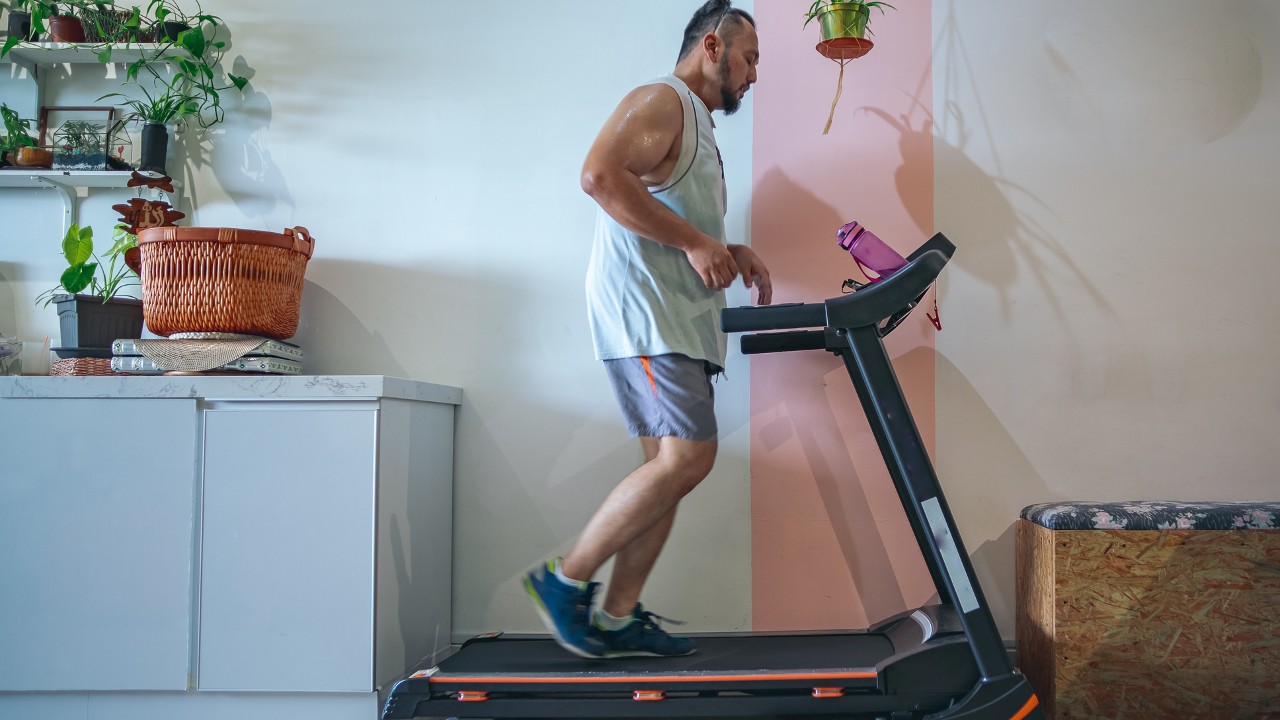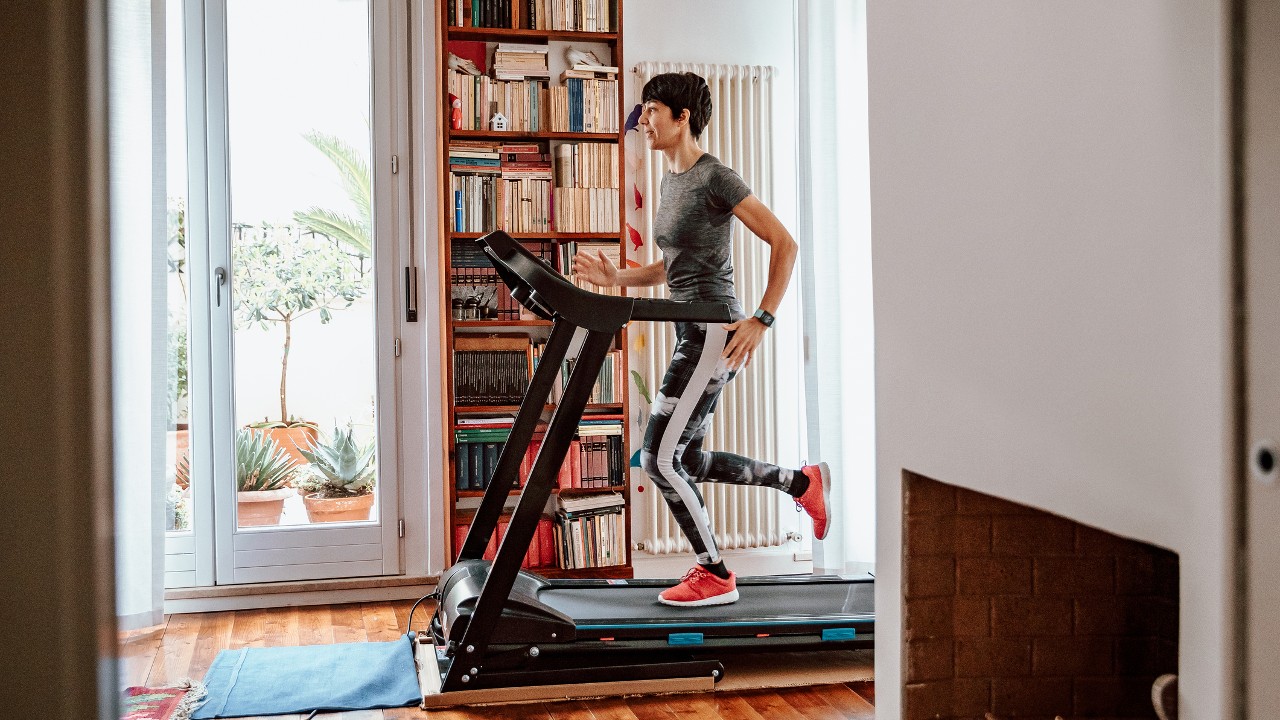The Benefits Of Treadmills: 4 Reasons To Jump On This Cardio Machine
An exercise physiologist breaks down some of the benefits of treadmills over outdoor running and other cardio machines

The main benefit of treadmills is that they grant a lot of control over your workouts, allowing you to monitor your speed and adjust your incline. But other than that, the benefits of running on a treadmill and running outdoors are remarkably similar.
“When comparing treadmill and outdoor running, energy consumption, muscle activity and load placed on joints are largely comparable,” explains Belinda Durey, a lecturer in clinical exercise physiology at the University of South Australia.
But there are a few advantages to using a treadmill that are worth highlighting – along with some drawbacks, too. We asked Durey to break them down for us.
The Benefits Of Treadmills
1. High Energy Expenditure
Treadmills allow you to run all year round, if you live in a place where the winters or summers make it dangerous to exercise outdoors. On top of that, running is great for your cardiovascular fitness.
“Running is a whole-body exercise: it involves all the major muscle groups,” Durey says. “For this reason, running expends more energy than many other forms of physical activity, and has the greatest impact on aerobic fitness.”
Several small studies have shown that treadmills can help you expend more energy than other popular gym machines, including one published in the Journal Of The American Medical Association. Different machines in the gym – like rowers and elliptical machines – might activate a higher number of muscle groups when compared with treadmills, but if energy expenditure is your main goal then the treadmill is your friend.
2. Progress Tracking
You can monitor your speed on a running watch when you’re outdoors, but it’s a lot easier to control this on a treadmill. You’ll also be able to control other environmental factors, which could have positive effects.
“The benefit of controlling your training – the temperature of the room, your pace – is that you can more easily predict and track progress,” says Durey. “When starting out as a runner, this is probably encouraging and beginners may find interval training – eg a couch to 5K plan – easier on a treadmill. For athletes, training on a treadmill will help to control any external barriers like weather and traffic, and offer some variety if they are putting in lots of kilometres outdoors.”
3. Breaking Up A Sedentary Lifestyle
You don’t have to go at top speeds to get some benefits from a treadmill – under-desk treadmills allow you to walk while you work.
Get the Coach Newsletter
Sign up for workout ideas, training advice, reviews of the latest gear and more.
“Limiting sedentary time is important as part of a healthy lifestyle,” says Durey. “Public health guidelines recommend we break up periods of sitting, and build activity into our daily routine. Standing is better than sitting, walking is better than standing and so on. Standing desks and under-desk treadmills provide the opportunity to include unstructured exercise in our day.”
And of course, you can position a screen near a normal treadmill and walk during presentations and video calls when you don’t have to turn your camera on.
4. Treadmill Running May Help With Rehabbing Knee Injuries
When we spoke to a trio of experts about whether running on a treadmill is bad for you compared with running outdoors, the overarching message was that they were broadly equivalent. However, one thing that was highlighted was that treadmill running could be better for people with knee pain.
“The science isn’t really strong about saying what’s good or bad, but there was one really good paper by Van Hooren et al, which was a meta-analysis on ‘is motorised treadmill running biomechanically comparable to overground running’,” says Alex Townsend, a specialist musculoskeletal (MSK) and sports podiatrist at Pure Sports Medicine.
“Largely, the comparisons are yes, it’s close enough. But the evidence in the literature for knee pain and ankle pain is reasonable. Knee pain is better with treadmill running. We see an increase in knee flexion at footstrike on a treadmill compared with track running, and we see a decrease in the range of motion with knee flexion. Often that dictates a shorter stride length, and there are arguments that a longer stride length with a lower cadence could potentially be a contributing factor to patellofemoral pain – front-of-the-knee pain. So you could make the argument that treadmill running may lead to a shorter stride length, which may mean that it could be less risky. I’m really cautious of quoting that, but it may be less risky.”

The Disadvantages Of Treadmill Running
1. No Decline Options Or Uneven Terrain
Very few treadmills offer a decline option, which means you can’t emulate downhill running. This type of training is more challenging than you might expect and offers various benefits.
“Running downhill is eccentric training,” explains Durey. “This means your muscles are lengthening while contracting, to support your bodyweight against gravity and absorb shock. This, put simply, creates more stress for the muscles.
“In the days after a session this often results in more delayed onset muscle soreness, or DOMS, but in the longer term there are beneficial adaptations that are unique to eccentric training. These include injury prevention, better strength gains, and more efficient energy use.”
Similarly, you can’t emulate uneven terrain on a treadmill, so your body misses out on the stimulus.
2. Treadmills Won't Prepare You For A Race
When you’re training for an event, you need to practise taking on environmental factors that are beyond your control, which you can’t really do on a treadmill.
“It is important to replicate the competition environment as closely as possible,” says Durey. “For example, with a marathon, it is important to run outdoors to prepare for any external influences, such as wind, humidity, uneven ground, differing surfaces. However, having a variety of training is also advantageous.”
Her advice for marathon prep? “A combination of outdoor running including hills, uneven surfaces and natural pace changes, plus treadmill running for controlled simulation of the competitive environment, is arguably best for marathon training.”
Belinda Durey is an exercise physiologist, lecturer and PhD candidate at the University of South Australia. She holds a master’s degree in Clinical Exercise Physiology from the University of Queensland and a bachelor’s degree of Applied Science from the University of South Australia.

Ruth Gaukrodger is the fitness editor for Coach and its sister site Fit&Well, responsible for editing articles on everything from fitness trackers to walking shoes. When she's not wrestling with equipment in our dedicated testing centre, you can find her pursuing running PBs around the streets of London or improving her yoga skills from the comfort of her living room. She’s a keen believer in working out for enjoyment first and is always open to hearing about fun new ways to exercise.
- Nick Harris-FrySenior writer
